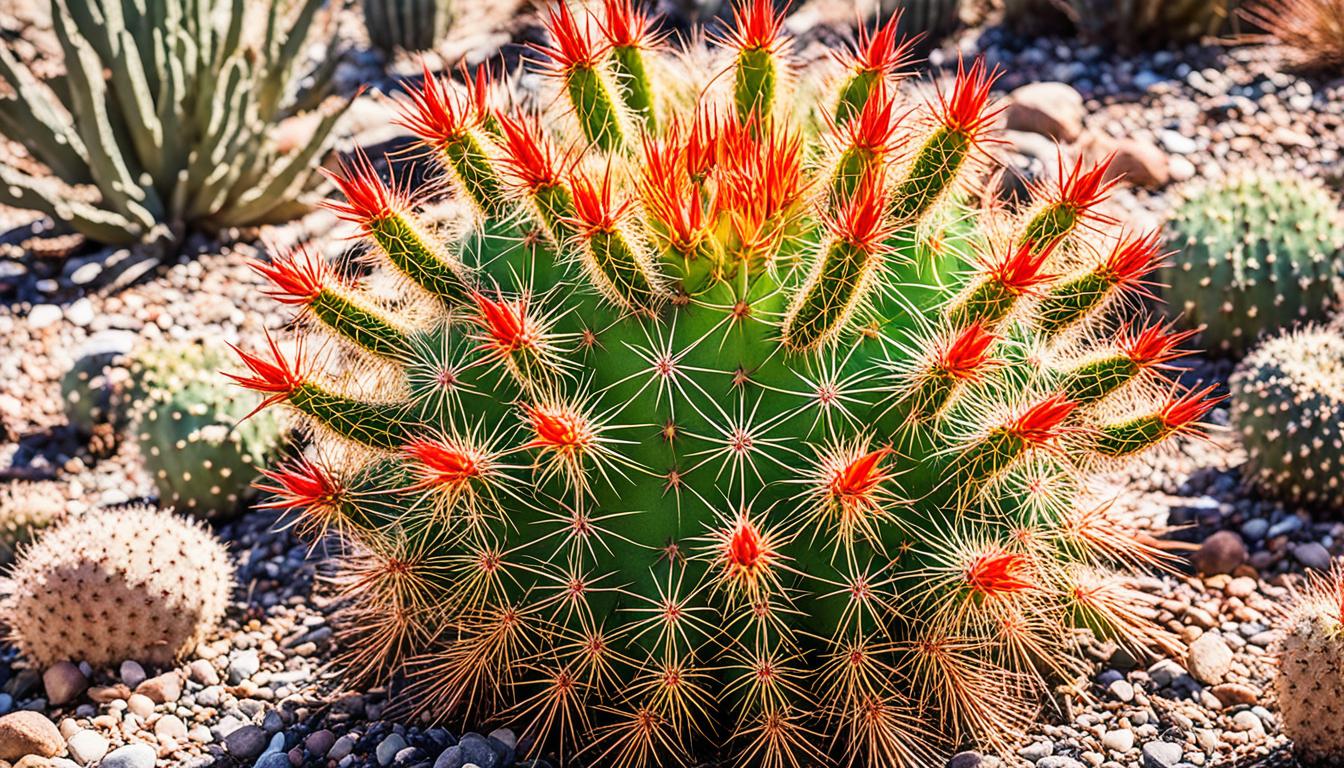Did you know the Bunny Ear Cactus is a top pick for people living in apartments? It looks unique and is easy to take care of. This guide will tell you how to look after one in your apartment. You’ll learn about its looks, light needs, water, food, and how to grow more.
Key Takeaways:
- Bunny Ear Cactus is chosen often by those living in apartments because of its unique look and easy care.
- Although it doesn’t clean the air, this cactus makes your home prettier and more charming.
- It’s safe for pets, but keep it away from them to avoid any upset or tummy troubles.
- This cactus can get as tall as 2 to 3 feet, perfect for small spaces.
- This guide covers choosing the right pot, soil, how to trim it, make new plants, and fight off bugs.
Why Do We Love the Bunny Ear Cactus For Apartments?
The Bunny Ear Cactus is a favorite for those living in apartments. Its ears look like a rabbit’s, bringing whimsy to your home. It’s also easy to take care of. This makes it great for people who are often busy.
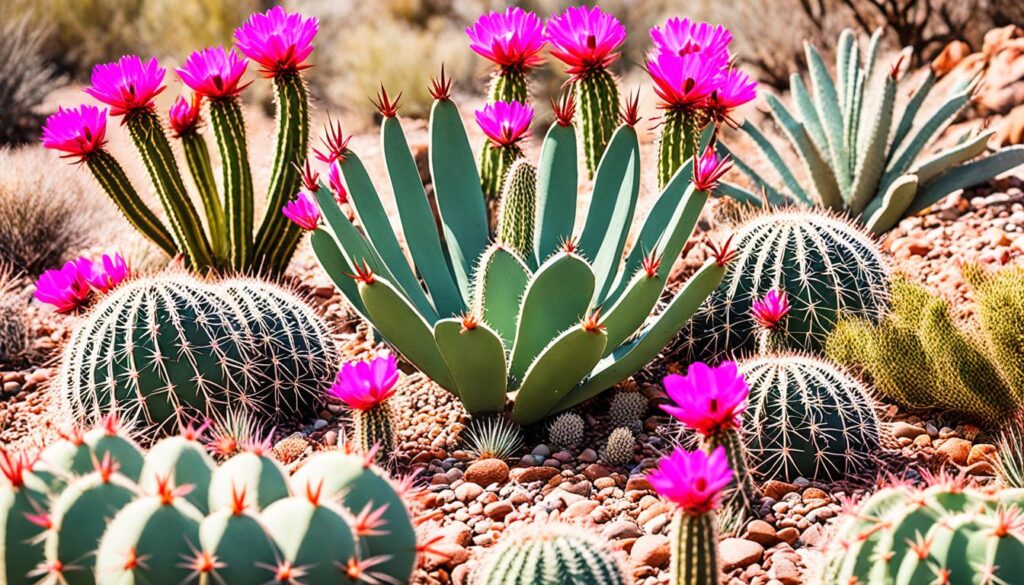
Is the Bunny Ear Cactus Air-Purifying?
This cactus might not clean the air. But it still makes your place look green and nice.
Is the Bunny Ear Cactus Pet Friendly?
This cactus is safe for pets. Yet, it’s best to put it where pets can’t reach. This keeps them safe from harm.
How Big Does the Bunny Ear Cactus Get?
This cactus can get as tall as 2 to 3 feet. Its growth is slow. So, it fits well in small spaces without taking over.
How to Grow a Bunny Ear Cactus – Learn to Grow this Indoor Beauty
Growing a Bunny Ear Cactus is easy if you know how. I’ll show you how to care for this cactus at home.
Choosing the Right Pot and Soil
First, pick the right pot and soil for your cactus. The pot must drain well and be a bit bigger than the cactus. Use a special cactus mix that helps roots breathe and stay healthy.
Providing Adequate Light
This cactus loves bright, indirect sunlight. Keep it near a window that’s sunny but not in direct light. If you don’t have enough sunlight, grow lights work too.
Watering and Humidity
It’s important to water your cactus the right way. Let the soil dry before you water it again. In warm months, water every 2-3 weeks. In cold months, water less. Add some moisture to the air around it sometimes.
Nutrition and Fertilization
A little food helps your cactus grow. Use a special cactus food lightly in spring and summer. Don’t overdo it, as too much can hurt the roots.
Pruning and Maintenance
Keep your cactus looking good by trimming off bad parts. Use clean tools. Check for bugs or sickness often. Keep your cactus clean by gently wiping its pads.
Propagation
You can make new cacti from cuttings or seeds. For cuttings, take a piece, let it dry, then plant it. For seeds, plant them in a sterile mix, keep them warm and moist.
Monitoring for Pests and Diseases
Watch out for pests and diseases on your cactus. Look for bugs or signs of sickness. If you see a problem, fix it with natural ways or safe treatments.
Appearance of Bunny Ear Cactus
The Bunny Ear Cactus is also known as Opuntia microdasys. It is a special kind of succulent. It looks unique with pads that look like bunny ears. These pads are playful and cute. They are also covered in short bristles known as glochids.
This cactus can be different colors. Its stems may be bright green or blue-green. This adds beauty to any room. The stems are smooth and firm. They are nice to look at and to touch.
The Bunny Ear Cactus grows in a special way. Its stems layer in a flattened style. This makes it look like a piece of architecture. As it gets older, it grows a thick, woody base. This makes it look strong and interesting.
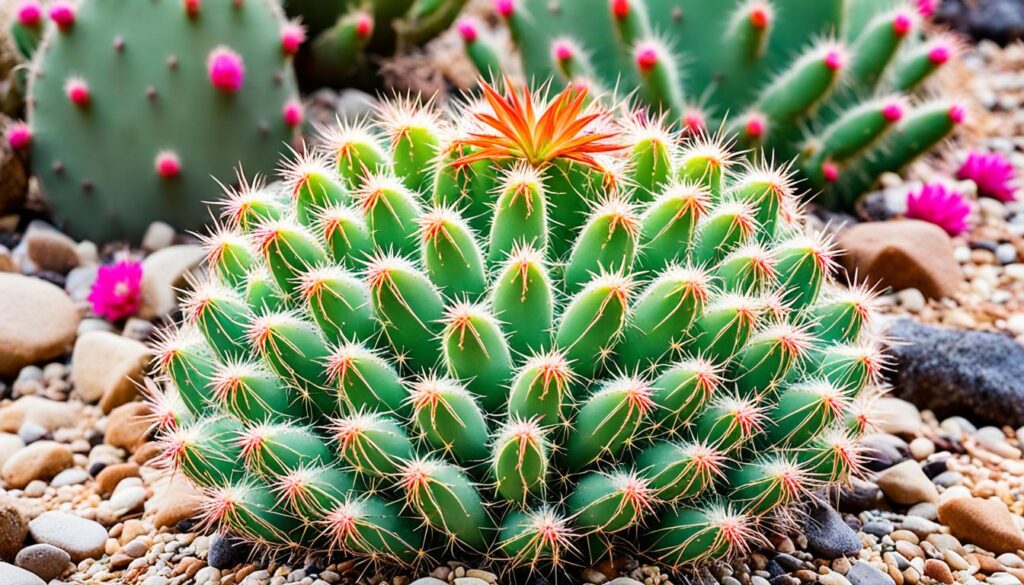
Light Requirements for Bunny Ear Cactus
Your Bunny Ear Cactus needs the right light to stay healthy and look good. It’s important to know how much light it needs.
The Bunny Ear Cactus loves bright, indirect sunlight. It needs 6 hours of sunlight a day. Put it near a window with bright, filtered sunlight.
But, don’t let it get too much direct sun in the afternoon. Too much direct sun can hurt its pads. Use a sheer curtain to protect it if needed.
If you don’t have enough natural light, use LED grow lights. They give your cactus the light it needs without too much heat.
Make sure to turn your cactus now and then. This keeps it from leaning too much to one side. It helps it grow evenly.
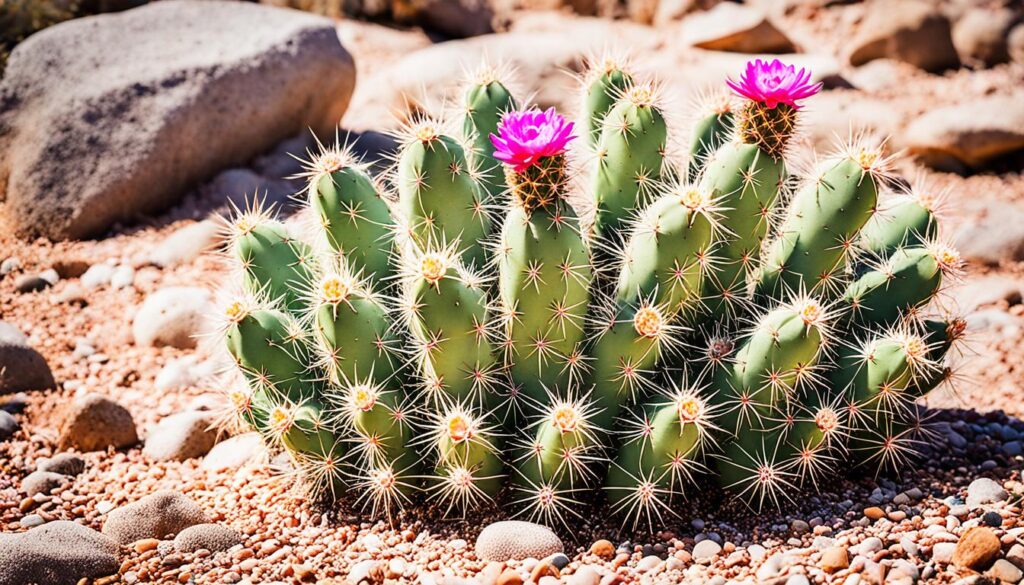
Watering Requirements of the Bunny Ear Cactus
Watering is key for your Bunny Ear Cactus’s health. It stops too much or too little water. I’ll share knowledge and tips on watering right.
Signs of Overwatering vs. Underwatering
Too much water is bad. It can cause root rot. Not enough water makes the cactus dry out. Knowing the signs is important.
Overwatered signs include:
- Yellow or soft cactus pads
- Mushy, discolored roots
- Bad smell from the soil
- Fungus or mold on soil
- Wilting cactus
Signs of not enough water:
- Shriveling cactus pads
- Dry and pale cactus
- Sunken pads
- Slow or no growth
- Color loss
Watch these signs to water right. This helps your cactus stay healthy.
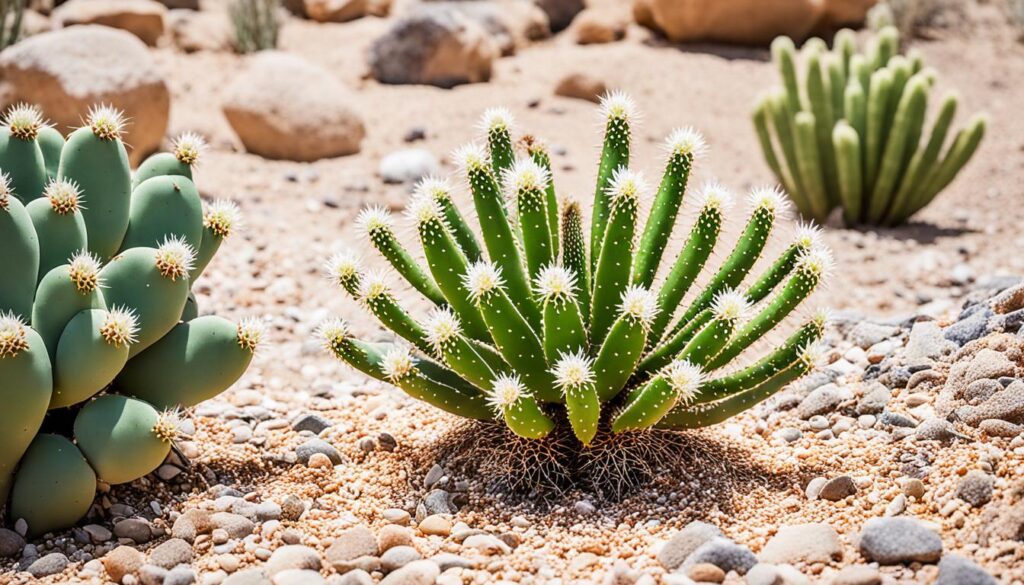
| Watering Recommendations | Frequency | Moisture Level |
|---|---|---|
| Spring and Summer | Once every 7-10 days | Let soil dry a bit between waterings |
| Fall and Winter | Water less often | Let soil almost fully dry before watering |
Use well-draining soil and a pot with holes for watering your cactus. This stops harmful waterlogging.
Adjust watering with the seasons for your cactus’s needs. Proper water helps your cactus look great.
Fertilizing a Bunny Ear Cactus
Fertilizing your Bunny Ear Cactus is key for its health. This plant doesn’t need much fertilizer. But, giving it the right food helps it grow well. Let’s talk about the best fertilizer for it and how to use it right.
Recommended Fertilizer for a Bunny Ear Cactus
Use a special cactus fertilizer for your Bunny Ear Cactus. It gives the plant important food like nitrogen, phosphorus, and potassium.
Find a fertilizer with a balance like 10-10-10 or 14-14-14. This balance helps the plant be healthy. You can get cactus fertilizer at a garden store or online.
When you fertilize, follow what the package says. You might need to make it weaker because cacti can’t handle too much. Put the weak fertilizer on the soil, not on the cactus itself.
Fertilize in spring and summer, once a month or every other month. Don’t fertilize in winter when the cactus is resting.
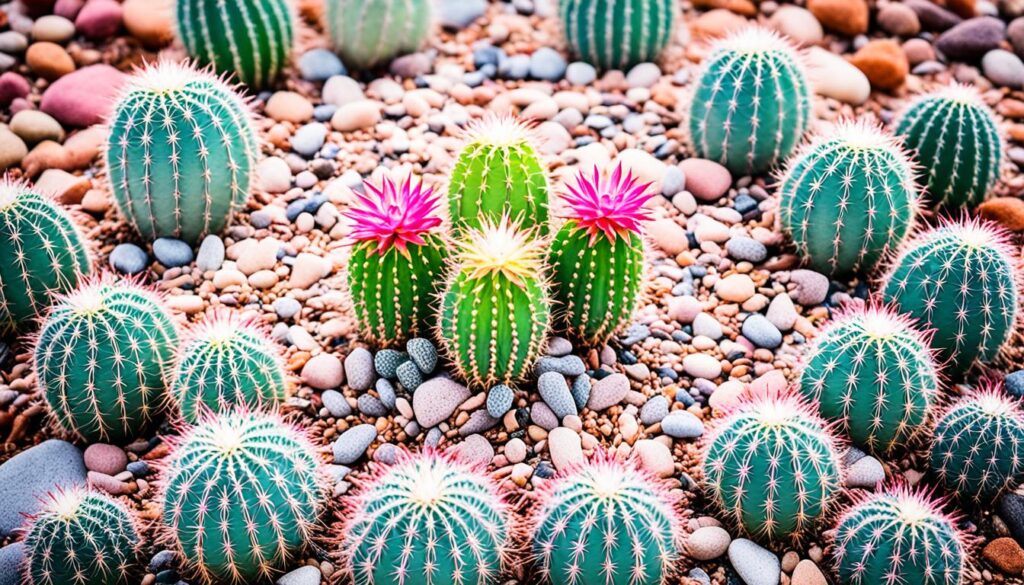
By using these tips, you help your Bunny Ear Cactus stay happy and healthy. It will grow well with the right food.
Potting a Bunny Ear Cactus
It’s really important to pot your Bunny Ear Cactus right. You need to think about the pot size, the soil, and when to repot it. This helps your cactus stay healthy and grow.
Choosing the Right Pot Size
Picking the right pot size for your cactus is key. A small pot can stop it from growing. But a big pot might hold too much water and harm the roots.
It’s best to get a pot that’s just 1-2 inches bigger than your cactus. This gives the roots space without too much water. Just make sure it’s not too big to avoid watering issues.
Using the Right Potting Mix for a Bunny Ear Cactus
The right soil mix is a must for your cactus. It needs to drain well but keep some moisture.
A great mix has things like perlite, sand, and peat moss. You can make your own with potting soil, perlite, and sand. Mix them in equal parts.
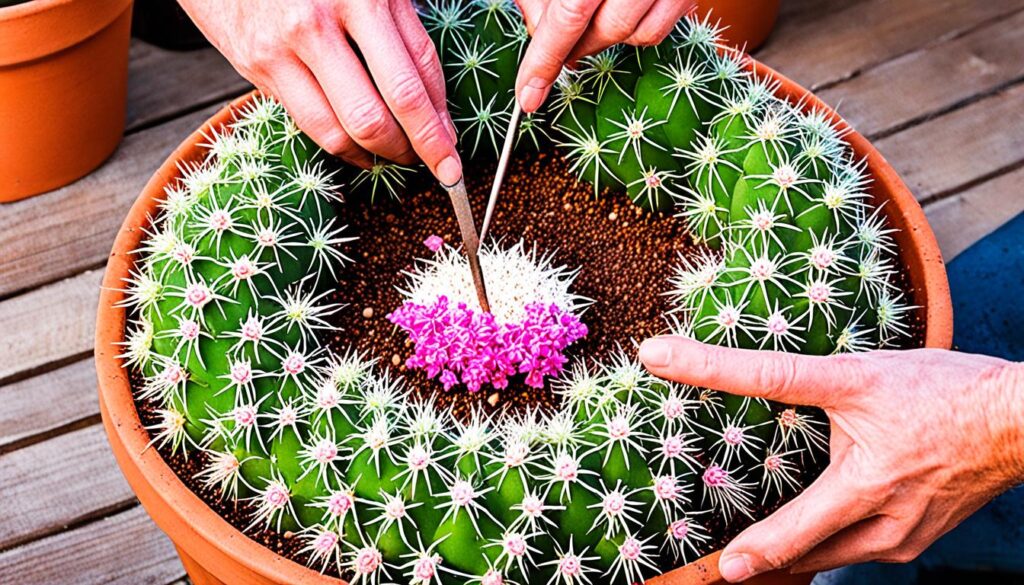
Repotting When Necessary
Sometimes, your cactus will need a new pot to keep growing. You can tell by looking at the roots and its size.
If the roots are everywhere or poking out, it’s time for a bigger pot. Do this in spring or early summer when the cactus grows most.
Be gentle when you move the cactus to a new pot. Loosen the roots carefully. Then, put it in the new pot with fresh soil. Water it a little and let it adjust to its new home.
Propagating a Bunny Ear Cactus
Making more Bunny Ear Cactus plants is fun. It lets you grow your plant family. You can do it by stem cuttings or division. Both ways need care but work well.
Stem Cuttings Or Seeds?
To start with stem cuttings, pick a healthy cactus pad. Cut it carefully. Let the cutting dry for a few days. Then, plant it in special cactus soil. Keep the soil a bit wet. Soon, in a few weeks, roots will grow.
Growing from seeds is another choice. It takes longer but is exciting. Put the seeds in special soil. They should not be too close together. Keep the pot in a warm, bright spot. Protect the seeds from direct sun. Make sure the soil is moist. After some time, little cactus plants will start to grow.
Division Of A Bunny Ear Cactus
You can also make more plants by dividing them. First, take the cactus out of its pot. Then, gently split it into parts. Each piece should have roots. Let them dry a bit, then plant each in new soil. Water them a little and take good care of them.
Whether you pick cuttings or division, it’s fun to make new cactus plants. This lets you have more lovely plants at home. With the right steps and care, your cacti will do great.
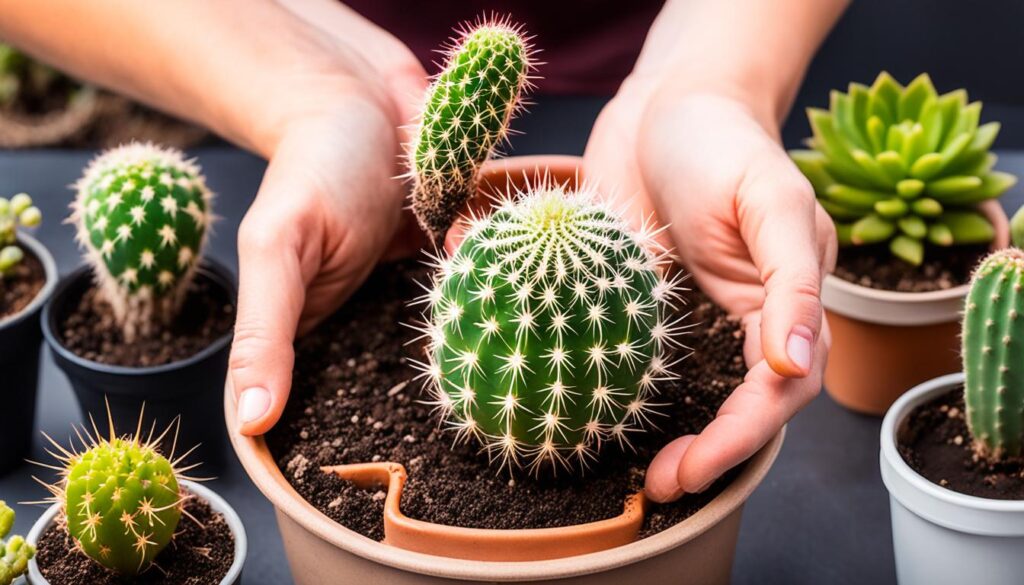
Growth and Development of the Bunny Ear Cactus
It’s important to know how a Bunny Ear Cactus grows and gets big. From a tiny seed to a big plant, every growth stage is key to its health and looks.
The journey starts with the seed sprouting. Soon, it grows pad-like stems with short bristles. These pads make it look special.
Then, it works on its roots. Strong roots help the plant stand firm and eat food.

Many things affect how fast it grows. Sunlight is important for making food and growing well. Watering and feeding it right matters too. Also, it needs the right warm and moist air to grow best.
With good care, it can get 2 to 3 feet tall. It grows slow. This makes it perfect for small places like apartments.
Knowing how the Bunny Ear Cactus grows helps you take care of it better. This helps anyone grow a healthy and pretty plant. It makes any space look nice.
Dealing with Pests and Diseases in the Bunny Ear Cactus
Bunny Ear Cactus can get sick like any plant. But, you can keep it healthy with the right care. I’ll talk about common pests and diseases. And how to prevent or treat them.
Pests
Mealybugs love Bunny Ear Cactus. They are small, white bugs that eat the plant’s sap. They can make the cactus weak by taking its nutrients. Check your cactus often for white, fuzzy spots. This means mealybugs are there. If you see them, wipe them off with rubbing alcohol on a cotton swab. You can also use ladybugs or insecticidal soap to get rid of them.
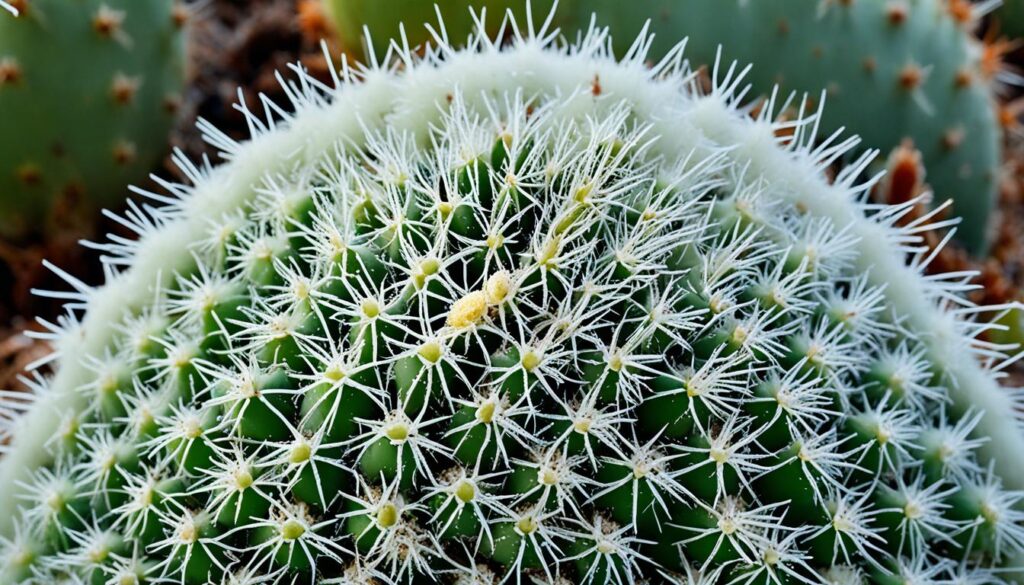
Diseases
Root rot is a big problem for Bunny Ear Cactus. It happens if you water too much or the soil doesn’t drain well. This disease makes the roots rot, killing the cactus. Use well-draining soil and water less to avoid root rot. If it happens, cut off the bad parts and put the cactus in new, dry soil. Check the roots are okay before you replant.
Bunny Ear Cactus can also get fungal and bacterial diseases. Keep it from getting too wet, ensure air can flow, and clean up dead parts. This helps prevent disease. If you see bad spots or the cactus looks sick, act fast. Remove sick parts and use a fungicide or bactericide as the label says.
Good care is key to a healthy Bunny Ear Cactus. Water right, use good soil, and keep it clean. Always check for pests and diseases. And treat problems fast. This way, your cactus will stay beautiful and healthy.
Common Bunny Ear Cactus Pests
Bugs can harm your Bunny Ear Cactus. Knowing what bugs like to eat your plant helps. When you see bug signs, you should act fast. This keeps your cactus safe.
Mealybugs and scale insects are bad for Bunny Ear Cactus. Mealybugs look like white, fluffy spots. They eat plant juice. Scale insects don’t move much. They make the cactus weak.
Look for these to find bugs:
- White fluff or sticky spots on the cactus
- The cactus’s pads turn yellow or droop
- Tiny, still bumps on the cactus
- The cactus stops growing well
If you see any signs, act fast to stop the bugs. Here’s how:
- Manual Removal: Clean the cactus with rubbing alcohol and cotton. Do this until the bugs are gone.
- Natural Predators: Put good bugs like ladybugs in your garden. They eat the bad bugs.
- Neem Oil: Use neem oil on the cactus. It keeps bugs away. Always follow the directions.
Stay alert and fight bugs early. This way, your Bunny Ear Cactus stays healthy.
Natural Predators
Nature has great helpers for keeping your Bunny Ear Cactus safe. These helpers don’t use chemicals. They are living things that eat the pests harming your cactus. This way, your indoor plants stay healthy and happy.
Isolate Infected Plants
Found pests on your Bunny Ear Cactus? It’s important to keep it away from others. This stops the pests from spreading. It also helps you focus on getting rid of the bugs without trouble.
Chemical Treatment
Some pests are tough, and you might need chemicals. If so, use them carefully and pick the right ones for cacti. Always follow the instructions. This keeps your cactus safe.
Disease Prevention For Bunny Ear Cacti
It’s vital to keep your Bunny Ear Cactus in good health. A few easy steps can help prevent diseases.
Below are tips to keep your Bunny Ear Cacti disease-free:
- Proper Hygiene: Clean your cactus’s pads with a soft, damp cloth. This stops dust buildup and keeps diseases away.
- Avoid Overwatering: Too much water can cause root rot. Use well-draining soil and let it dry before watering again. Water based on your cactus’s needs and your home’s environment.
- Adequate Air Circulation: Your cactus needs good air flow. Don’t put it in very humid or still air. A small fan can help if needed.
- Quarantine New Plants: Keep new cacti alone for a few weeks first. This prevents any diseases or pests from spreading.
- Pest Control: Look for pests like mealybugs. If you find any, act fast with safe pest control.
- Maintain Optimal Growing Conditions: Make sure your cactus gets enough light, water, and food. A happy plant fights off diseases better.
Always remember, it’s better to prevent than to treat diseases in Bunny Ear Cacti. With these steps, your plant will flourish.
Tips for Maintaining Bunny Ear Cacti
It’s important to keep your Bunny Ear Cacti healthy. Here are some tips to help your cactus plants do well.
Wiping Leaves
Wipe the leaves of your Bunny Ear Cacti regularly. This keeps them clean and avoids pests. Use a soft cloth with a bit of water. Be gentle and don’t make the plant too wet. This makes your cacti look fresh and bright.
Outdoor Exposure
Bunny Ear Cacti like being indoors but enjoy some outdoor time too. Take them outside when it’s nice. Start with a few hours in the shade. Then, slowly let them stay out longer. Sunlight and air outside make them grow strong.
Adjusting Watering Schedule
Change how much you water with the seasons. In cold months, water less because the cacti grow slow. Check the soil to avoid too much water. In warm months, they need more water to stay hydrated. Right watering keeps your cacti happy.
Tips for Successful Overwintering of Bunny Ear Cactus
It’s key to help Bunny Ear Cactus survive the cold. With some easy tips, your cactus can do well in winter.
- Control the temperature: This cactus loves warmth. Keep it between 60°F and 70°F (15°C and 21°C). Stay away from cold and drafts.
- Adjust lighting: These plants need lots of light. In winter, put them near a south window or use grow lights. They need 6-8 hours of light daily.
- Water sparingly: Even though it’s tough, it needs water in winter. Water every 3-4 weeks when the soil is dry. Too much water is bad.
- Protect from frost: Bunny Ear Cactus can’t handle cold. Move it inside before it freezes. Keep it away from cold windows and drafts inside.
Follow these tips to keep your Bunny Ear Cactus happy this winter.
Growing Bunny Ear Cactus from Seed
Growing Bunny Ear Cactus from seed is rewarding. You see the cactus grow from start to finish. I’ll show you how to do it step by step.
- Preparation: First, collect everything you need. This includes seeds, a well-draining pot or tray, cactus mix, and a spray bottle.
- Planting: Put the soil in the pot or tray. Leave some space at the top. Make the soil damp but not wet. Then, put the seeds in the soil spaced out well.
- Care: Keep the pot in a warm, sunny spot but not in direct sun. It should stay between 70-80°F. Spray the soil when it dries out to keep it moist.
- Germination: Seeds will begin to grow in 1-3 weeks. Keep the soil moist by spraying. Give the seedlings enough light for them to grow strong.
- Transplantation: When they’re big enough, move the seedlings to their pots. Use the same kind of soil. Make sure they have room to grow.
- Continued Care: Keep giving them light but avoid direct sunlight. Water them when the soil dries. This helps them grow big and healthy.
Patient care is the key to growing Bunny Ear Cactus from seed. The reward is seeing your cacti grow from tiny seeds to big plants. Enjoy this growing journey!
Varieties of Bunny Ear Cactus
Looking for something unique for your plants at home? Bunny Ear Cactus has many types. Each type looks different and grows in its own way. Let’s look at some popular types:
Opuntia microdasys “Bunny Ears”
The “Bunny Ears” type is very well-known. It has round, flat pads that look like bunny ears. It’s small and cute. Plant lovers really like it because it makes any space fun.
Opuntia microdasys “Albata”
The “Albata” type has light green pads. It looks really pretty with other green plants. It’s good at adapting to various kinds of light. So, it’s great for any home garden.
Opuntia microdasys “Gold Bunny”
Want something with a golden touch? Try the “Gold Bunny” type. It has bright golden-yellow pads. This gives a warm and sunny look to your place. It stands out because of its color and makes everything cheerful.
These are a few examples of Bunny Ear Cactus types. Each one has its own special look and feel. They let you pick the best one for your taste and home.
You can pick from “Bunny Ears”, “Albata”, or “Gold Bunny”. Any Bunny Ear Cactus type will make your plant collection more joyful and pretty. Each variety boasts its unique charm, adding character to any indoor or outdoor space. Additionally, if you’re looking to complement your Bunny Ears, consider adding a golden barrel cactus for a striking contrast. For those interested in providing the best environment, don’t forget to research golden barrel cactus care tips to ensure both plants thrive together beautifully.
FAQ
Q: Is the Bunny Ear Cactus air-purifying?
A: No, the Bunny Ear Cactus does not clean the air. But, it does make your home look nice.
Q: Is the Bunny Ear Cactus pet friendly?
A: Yes, Bunny Ear Cactus is safe for pets. But keep it away from them to avoid any trouble.
Q: How big does the Bunny Ear Cactus get?
A: This cactus can get as tall as 2 to 3 feet. It grows slowly, which is perfect for small spaces.
Q: How do I choose the right pot and soil for my Bunny Ear Cactus?
A: Choosing the right pot and soil is very important. Use a pot with holes and soil that drains well.
Q: How much light does a Bunny Ear Cactus need?
A: It loves bright light but not directly from the sun. A window spot is good, or use a grow light.
Q: How often should I water my Bunny Ear Cactus?
A: Water it well but not too often. Let the soil dry completely first. The weather affects how much water it needs.
Q: Does Bunny Ear Cactus require fertilization?
A: Feeding your cactus helps it grow. Use a balanced fertilizer, but not too much.
Q: How do I prune and maintain my Bunny Ear Cactus?
A: Keep your cactus looking its best by pruning. Take off dead parts and trim it. Be careful, use gloves!
Q: How do I propagate my Bunny Ear Cactus?
A: You can grow more cacti from cuttings or seeds. For cuttings, take a pad, let it dry, and then plant it. For seeds, plant them as the directions say.
Q: What are some common pests and diseases that can affect Bunny Ear Cactus?
A: Watch out for bugs like mealybugs and problems like root rot. Check your cactus often to keep it healthy.
Q: What does a Bunny Ear Cactus look like?
A: It has flat green pads with tiny bristles. It looks really cool and grows in a bunch.
Q: How do I provide the right amount of light for my Bunny Ear Cactus?
A: Give it lots of light but keep it from direct sun. Rotate it to get light everywhere.
Q: How do I water my Bunny Ear Cactus without overwatering or underwatering it?
A: Water it right by letting it drain. Wait for the soil to dry before watering again. Change the schedule with the weather.
Q: What are the signs of overwatering and underwatering in Bunny Ear Cactus?
A: Too much water makes it mushy and smelly. Not enough water, it gets dry and wrinkly. Adjust water as needed.
Q: What fertilizers are recommended for Bunny Ear Cactus?
A: Use a balanced fertilizer like 10-10-10. Dilute it and follow the directions.
Q: How do I choose the right pot size and potting mix for my Bunny Ear Cactus?
A: Get a pot a bit bigger with drainage. Mix soil with perlite or sand for good drainage.
Q: How do I propagate Bunny Ear Cactus through stem cuttings or division?
A: For cuttings, take a pad, let it dry, then plant. For division, separate and repot with care.
Q: How does the Bunny Ear Cactus grow and develop over time?
A: It starts small and grows bigger. New pads form, making more plants. Light, water, and food matter a lot.
Q: What are some common pests that can affect Bunny Ear Cactus?
A: Watch out for mealybugs, scale insects, and spider mites. Check often and keep your cactus clean.
Q: Are there natural predators that can help control pests on my Bunny Ear Cactus?
A: Yes, ladybugs and lacewings eat bad bugs. They help keep your cactus safe without chemicals.
Q: What should I do if I notice pest or disease issues on my Bunny Ear Cactus?
A: If there’s a problem, keep the cactus alone first. Then, remove bad parts and treat it right.
Q: When is chemical treatment necessary to control pests or diseases on my Bunny Ear Cactus?
A: Use chemicals if the problem is very bad. Pick ones made for cacti and use them safely.
Q: What are some tips for preventing common diseases in Bunny Ear Cactus?
A: Water it well but not too much. Use fast-draining soil and clean up bad parts fast.
Q: How do I maintain my Bunny Ear Cacti?
A: Clean them with a cloth to remove dust. Give them some outside time. Change the water schedule with the season. Watch for any problems.
Q: How do I overwinter my Bunny Ear Cactus?
A: In winter, keep it cool and dry. Water less and protect it from cold. Make sure it gets enough light.
Q: How do I grow Bunny Ear Cactus from seed?
A: Plant the seeds in good soil. Keep them warm and moist. Give them light but not direct sun.
Q: What are some popular varieties of Bunny Ear Cactus?
A: There are different types of Bunny Ear Cactus. Some common ones are ‘Albata’, ‘Sunrise’, and ‘Bunny Blue’.

